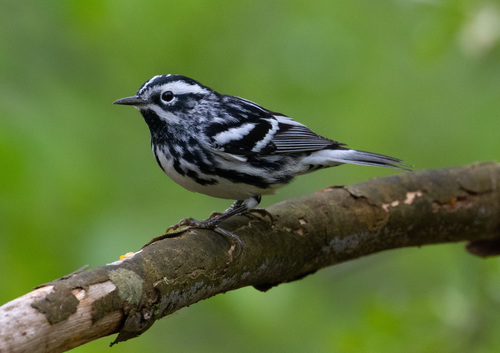
Black-and-white Warbler
The Black-and-white Warbler (Mniotilta varia) is a small, striking songbird known for its unique foraging behavior, often described as creeping along tree trunks and branches like a nuthatch. This behavior, unusual for a warbler, allows it to exploit a niche not utilized by other warblers, gleaning insects from bark crevices. It plays a crucial role in forest ecosystems by controlling insect populations. While not holding significant cultural meaning across broad regions, it is a welcome sight for birdwatchers, signifying the return of spring migrants in North America.
11-13 cm
Length
18-22 cm
Wingspan
Least Concern
Conservation Status
Distribution
Breeds across eastern and central North America, from southern Canada to the southeastern United States. Winters in Florida, Central America, the West Indies, and northern South America. Migrates through much of the eastern United States and along the Gulf Coast.
Lifespan
Up to 11 years (recorded in the wild), though the average is likely shorter.
Black-and-white Warbler's Habitat
Habitat Types
Deciduous forests, Mixed forests, Wooded swamps, Mature second-growth woodlands
Climate Zones
Temperate, Subtropical
Adaptations
Its nuthatch-like foraging behavior, using its long, slightly curved bill and strong legs and feet, enables it to access food resources in bark crevices that other warblers cannot reach. This adaptation reduces competition for resources.
Variations
No recognized subspecies.
Appearance
Breeding Plumage
Breeding males have bolder black and white streaking, particularly on the throat and flanks. Females and non-breeding males are duller, with less distinct streaking and sometimes a buffy wash on the flanks.
Seasonal Feather Changes
Some seasonal variation, with breeding plumage being brighter and more contrasting.
Sex Based Plumage Differences
Males have a black throat and more pronounced black streaks on the crown and back. Females have a white or grayish throat and less distinct streaking.
Notable Features
Bold black and white streaking all over the body., White central crown stripe., Black and white striped wings., Long, slightly decurved bill.
Diet and Feeding
Primary Foods
Insects, Spiders, Caterpillars, Insect larvae
Foraging Behavior
Creeps along tree trunks and branches, probing bark crevices for insects, similar to a nuthatch. Also gleans insects from leaves and occasionally catches insects in flight.
Specializations
Its foraging behavior, long, slightly curved bill, and strong legs and feet are all specializations for accessing insects in bark.
Seasonal Diet Variations
Diet is primarily insects throughout the year. During migration and winter, may supplement diet with some berries and seeds, but this is a minor component.
Behavior
Social Structure
Generally solitary or in pairs during the breeding season. May join mixed-species flocks during migration and on the wintering grounds.
Communication
A high-pitched, thin, and repetitive 'wee-see-wee-see-wee-see' song., A sharp 'chip' call note.
Migration
A long-distance migrant, traveling between North America and Central/South America. Migrates primarily at night.
Territorial or Group Behaviors
Males are territorial during the breeding season, defending their territory through song and chases. Outside of breeding season, they are less territorial.
Conservation
Threats
Habitat loss and fragmentation (both breeding and wintering grounds), Collisions with buildings during migration, Pesticide use (reducing insect prey)
Protection Programs
Protected under the Migratory Bird Treaty Act in the US and Canada., General forest conservation efforts benefit this species.
Local National Laws
Migratory Bird Treaty Act (US and Canada)
Population Trend
Stable
Population Estimates
Estimated global breeding population of 18 million.
Interesting Facts
They are one of the earliest warblers to arrive on their breeding grounds in spring.
This early arrival allows them to establish territories before many other species.
Unlike most warblers, they often forage on the ground.
This behavior is linked to their preference for nesting on the ground.
The genus name, *Mniotilta*, means 'moss-plucking,' referring to its foraging habits.
This name highlights its unique foraging behavior, picking insects from moss and bark.
The oldest recorded Black-and-white Warbler was at least 11 years, 3 months old.
This individual was recaptured and re-released during banding operations in Maryland.
Faqs about Black-and-white Warbler
What do Black-and-white Warblers eat?
They primarily eat insects, spiders, caterpillars, and insect larvae, which they find by creeping along tree trunks and branches.
Where do Black-and-white Warblers nest?
They build cup-shaped nests on the ground, usually at the base of a tree, shrub, or rock, hidden by vegetation.
Are Black-and-white Warblers endangered?
No, they are classified as 'Least Concern' by the IUCN, meaning their population is relatively stable.
How can I attract Black-and-white Warblers to my yard?
Maintaining a diverse, mature woodland habitat with plenty of native trees and shrubs is the best way to attract them. Avoid using pesticides.
Do both the male and female Black-and-white Warbler sing?
Primarily the male sings to defend territory and attract a mate. The female may give call notes, but does not have a complex song.
Copyright @ Nature Style Limited. All Rights Reserved.
 English
English